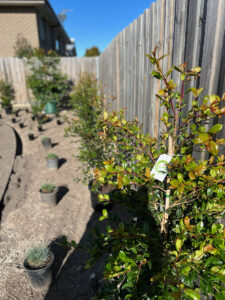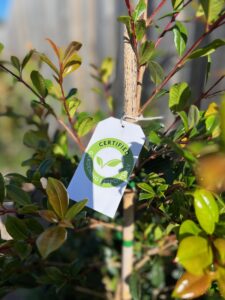
Look good, feel good by planting a certified low-risk garden
By Julia Rayment and Aimee Freimanis
The greenlife industry of the horticulture sector plays a significant role in contributing to the economy, influencing the wellbeing of society, and shaping landscapes directly and indirectly. In 2019-2020, the greenlife industry generated more than $3 billion of production value (DAFF, 2021). Proximity to green space, street trees, and private gardens is known to influence the wellbeing of a population (Bratman et. al 2019, Hall & Knuth 2019). Consumers purchase plants that positively influence all aspects of their wellbeing, from spiritual and mental wellbeing to social and environmental (Bratman et. Al 2019, Hall & Knuth 2019). This is in line with research that identified that consumers would be more likely to purchase a plant marketed as eco-friendly and would be willing to pay more for it.
Gardening Responsibly is a new initiative launching this September that allows people to do just that, with a Certified Gardening Responsibly eco-label. The eco-label signifies a plant has been assessed as ‘low-risk’ and is unlikely to ‘jump the garden fence’ and become a weed in other landscapes. Gardening Responsibly aims to keep our gardens beautiful and our native land safe from invasive garden escapes.

The uncontrolled introduction and cultivation of ornamental plants can be a threat to our unique flora and native biodiversity and 72% of weed species were accidently introduced as garden ornamentals. A 2005 report, Jumping the Garden Fence, produced by the CSIRO for the World Wildlife Fund, expressed concern about the number of invasive garden plants that were still available for sale to Australian gardeners.
Anyone can choose to garden with certified Gardening Responsibly plants, to reduce propagule pressure of invasive plants causing harm to our environment.
Previous initiatives such as the popular and effective Grow Me Instead booklet encouraged gardeners to plant alternative garden plants instead of common invasive plants. Suppliers too, make informed choices to minimise risk. Plant Breeders Rights encourage breeders to create distinct, stable and uniform cultivars. Todd Layt from Ozbreed explains, “Great exotic species can be improved through breeding, and their invasive qualities either reduced or eliminated. Many exotics have been selected by seed growers for prolific seed set. We do the opposite by looking for low to no seed set in our trials.’’ While Grow Me Instead helped gardeners make informed choices, and PBR promotes high standards and drives innovation for the horticultural industry, Gardening Responsibly offers a dynamic system and a citizen science public access research portal. This voluntary scheme is designed to speed up information sharing and education about plant traits and behaviour in situ. All horticulturists are encouraged to contribute their knowledge to the portal to grow evidence about invasive risk of ornamental plants. Through inclusivity, Gardening Responsibly enables people across the sector to make choices that will minimise negative consequences of escaped ornamental plants.
Gardening Responsibly is a cross sectoral initiative developed by the Consortium (Australian Institute of Horticulture, Nursery & Garden Industry NSW & ACT and the NSW government), using research from Macquarie Universality and the University of Wollongong. Using the best available science, the scheme assesses the invasive risk of ornamental plants for sale in Australia, with over 650 plants already assessed.
As a member, you can view the Gardening Responsibly plant database to ‘check your choice’ or assess one of the 4,000 ornamental plants in our database. We know that people don’t want to unknowingly trade garden plants that could become invasive in the future because ‘once it escapes, it’s too late’. Invasive weeds cost tax payers billions of dollars each year to manage, and cause harm to more than a thousand threatened and endangered species. Instead, our system makes transparent the factors of invasiveness to better understand invasive risk, and to empower nurseries, landscapers, architects and designers, government and gardeners alike, to make better choices.

Chris Poulton from Riverview Landscapes signed up as a Gardening Responsibly supplier and is planting a pocket park site in Sydney. He cross referenced his plant palette with our plants database before planting. While some plants, such as the Lilly Pilly (Syzygium australe ‘Resilience’) he had opted for were certified low risk, he discovered one plant choice, Alternanthera dentata ‘Little Ruby’ a small evergreen perennial shrub with reddish-purple foliage, was assessed as a ‘higher risk’ plant in the database. Chris checked the invasive factors for Alternanthera dentata ‘Little Ruby’and chose not to plant it. The evidence showed it is actually a cultivar of Alternanthera brasiliana (Syn. A. dentata) a known weed in QLD and NT.
Currently there is no evidence to suggest it is less vigorous than the parent species as it is able to spread vegetatively and grow fast. This species is not recommended for warm, humid (subtropical or tropical) areas near bushland or waterways. Feeling better informed, he made the choice to substitute Alternanthera dentata ‘Little Ruby’ with Festuca glauca as it offered the colour contrast he wanted, and in this case was a good alternative and has been certified low invasive risk. Chris was “excited he [could] use best practice in one of its forms.” Chris joined the scheme as he doesn’t want to “become complacent and wants to make better informed choices.” He hopes that “industry embraces this idea and we work together to get best practice across the horticulture sector to continue to create beautiful gardens and protect our natural Australian landscapes”. Using the knowledge, pride and support of each other to champion Gardening Responsibly, like Chris, you can sign up to Gardening Responsibly to check your choice or become a supplier.
The greenlife industry is committed to stemming the spread of weeds from Australian gardens. Gardening Responsibly is voluntary and we encourage you to join this movement to make informed, confident choices and help others do the same. Gardening Responsibly needs everyone’s help to be successful. Joining this initiative shows your commitment to the industry, the buyers, and our unique Australian landscape.
Julia Rayment, NSW Department of Planning and Environment, Sydney NSW
Aimee Freimanis, EcoHort Pty Ltd, Glenhaven NSW
Main photo: Chris Poulton’s certified low risk Gardening Responsibly park with Syzygium australe ‘Resilience’ in the foreground and Festuca glauca (Image: Aimee Freimanis)
References
Department of Agriculture, Fisheries and Forestry. (2021) Horticulture Fact Sheet. Available at: https://www.agriculture.gov.au/agriculture-land/farm-food-drought/hort-policy/horticulture_fact_sheet#trade-statistics (Accessed: 16/08/2022)
Bratman, G.N., Anderson, C.B., Berman, M.G., Cochran, B., De Vries, S., Flanders, J., Folke, C., Frumkin, H., Gross, J.J., Hartig, T. and Kahn Jr, P.H., 2019. Nature and mental health: An ecosystem service perspective. Science advances, 5(7).
Hall, C. and Knuth, M., 2019. An update of the literature supporting the well-being benefits of plants: A review of the emotional and mental health benefits of plants. Journal of Environmental Horticulture, 37(1), pp. 30-38.
How to Garden Responsibly (2021). Available at: https://www.gardeningresponsibly.org.au/about/how-to-garden-responsibly/ (Accessed 16/08/2022)
